#fenugreek recipes
Text
How to make Methi Malai Paneer Restaurant-Style
Methi Malai Paneer Restaurant-Style
Methi Malai Paneer Restaurant-Style is a popular Indian dish made with paneer (Indian cottage cheese), fresh fenugreek leaves (methi ), and cream (malai). The dish is known for its creamy texture, delicate flavour, and aromatic spices. Make this one of the meals for any special occasion, and I am sure your guests will wipe their plates clean. This one is also…

View On WordPress
#Cooking with Paneer#Creamy Indian Curry#Creamy Paneer Dish#Creamy Paneer Dishes#Delicious Paneer Dishes#Easy Paneer Recipes#fenugreek leaves#Fenugreek Recipes#Healthy Indian Recipes#healthy recipes#Homemade Indian Food#Homemade Paneer#Indian Cottage Cheese#Indian Cuisine#Indian Vegetarian Curry#malai#methi#Methi (Fenugreek) Recipes#Methi Malai Paneer#methi malai paneer banane ki vidhi#methi malai paneer kaise banaen#Methi Malai Paneer Recipe#methi malai paneer recipe dhaba style#methi malai paneer recipe in hindi#methi malai paneer recipe indian#methi malai paneer recipe step by step#Methi Paneer Masala#methi recipes#North Indian Cuisine#North Indian Recipes
0 notes
Text
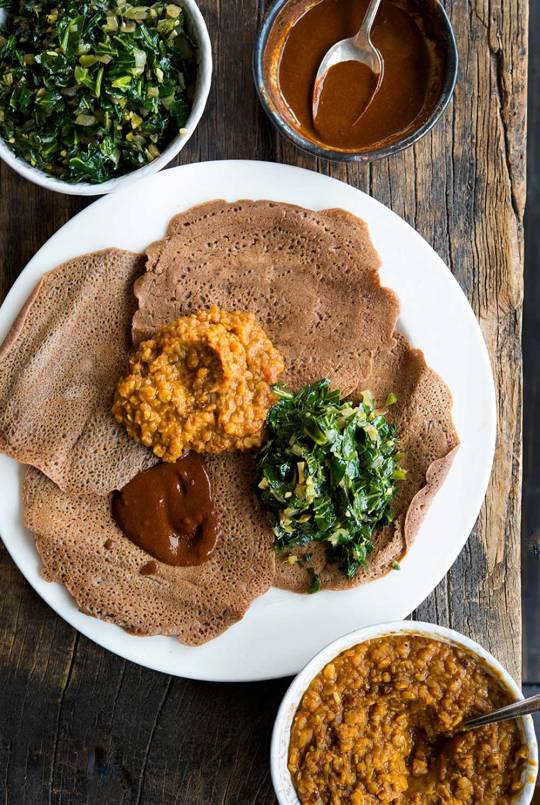
Ethiopian Red Lentil Stew and Collard Greens on Homemade Injera
#food#recipe#dinner#misir wat#gomen#collard greens#onions#tomatoes#lentils#butter#ginger#fenugreek#cardamom#cinnamon#turmeric#nigella seed#berbere#stew#garlic#bread#teff#ethiopian
84 notes
·
View notes
Text
making soup is an incredible experience everyone should make soup
#i never follow a recipe this time i did chicken spinach & carrots#fenugreek blk pepper cayenne paprika cumin#tagged
5 notes
·
View notes
Text
hell yeah I'm all about that grind, if by "grind" you mean crushing and blending herbs and whole spices to create a fragrant array of international spice blends to use in my next delicious meal
#my top recommendation is khmeli suneli which is georgian & so so good#heavy on coriander & fenugreek which are two of my very favorite spices#we discovered it when making a PHENOMENAL tomato sauce called pamidvris satsebeli#hmu if you want the recipe because god it's good
2 notes
·
View notes
Text
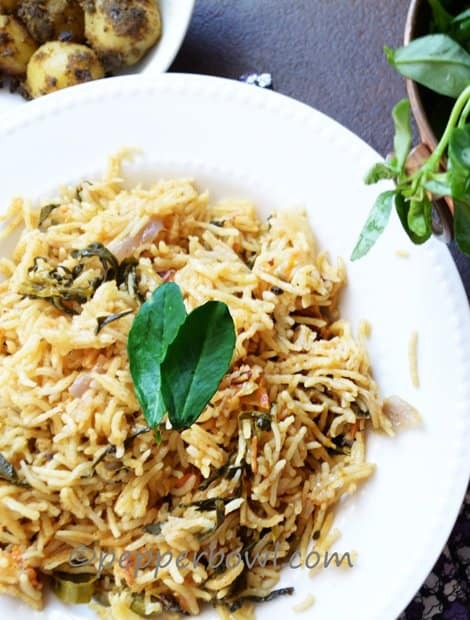
This Methi Biryani yields a spicy, flavorful, nutrient-rich Biryani. It is straightforward to make and explained in step-by-step pictures and detailed instructions.
#biryani#fenugreek#recipes#recipe#methi#taste#tasty#tasty recipes#delicious#spicy stuff#spicy food#spices#food#eats#flavor
0 notes
Text
Explore the Abundance of Health Benefits in Fenugreek Seeds
Fenugreek seeds, nestled within the confines of ancient herbal remedies are tiny yet mighty seeds that boast a plethora of health benefits. Often used as a spice in culinary dishes, fenugreek (Trigonella foenum-graecum) has been cherished for centuries in traditional medicine due to its remarkable medicinal properties.
Fenugreek seeds are a nutritional powerhouse, offering a range of health benefits that have been cherished for centuries. From regulating blood sugar levels to supporting heart health and aiding digestion, these tiny seeds pack a punch when it comes to enhancing overall well-being. And, incorporating fenugreek seeds into your diet, in moderation, can be a flavorful and beneficial addition to your journey toward a healthier lifestyle.
Check out this list of certain health benefits that these small but powerful fenugreek seeds offer.
1. Regulating Blood Sugar Levels

Fenugreek seeds are renowned for their ability to regulate blood sugar levels. Several studies have shown that the soluble fiber in fenugreek seeds helps to lower blood sugar by slowing down the absorption of carbohydrates and sugar. For individuals with diabetes or those looking to manage their blood glucose levels, incorporating fenugreek seeds into their diet can be immensely beneficial.
To Read More Click here...
#health#healthy#healthy life#healthy diet#tips for health#healthy tips#healthy recipes#Fenugreek Seeds#Sugar Levels#Regulating Blood
0 notes
Text
Green Gram Dosai
Nutrient-Packed Green Gram Dosai: A Healthy Twist on Tradition.In the realm of South Indian cuisine, dosai holds a cherished place. The classic dosai, prepared with a blend of black gram (urad dal) and rice, has been a breakfast staple for generations. However, there’s a lesser-known variation that offers both a delightful change of pace and a nutritional boost – the Green Gram Dosai. Unlike its…
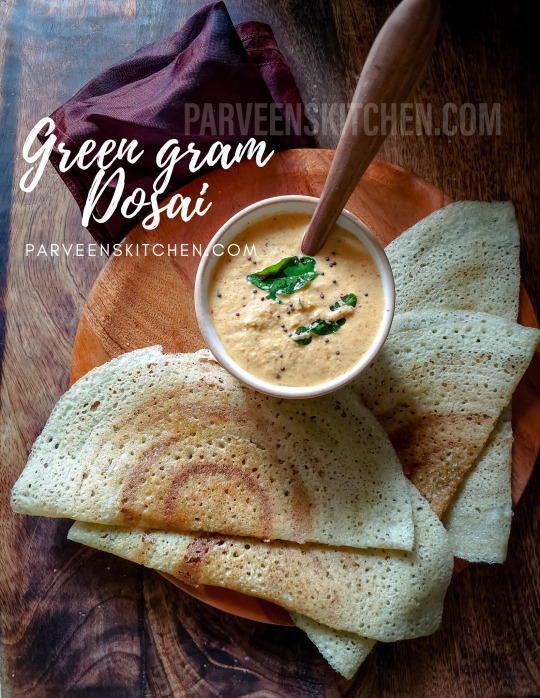
View On WordPress
#Digestion-Friendly Dosai#Easy Dosai Recipe#Easy recipes#Fenugreek Seeds#green Gram dosai#Healthy Dosai Recipe#High Protein Dosai#Idli Rice#Indian recipes#Moong Dal Dosai#Nutritious Breakfast#south indian cuisine#Traditional Indian Recipe#Vegetarian#Weight-Friendly Dosai
0 notes
Text
FENUGREEK LEAVES/METHI PARATHA/
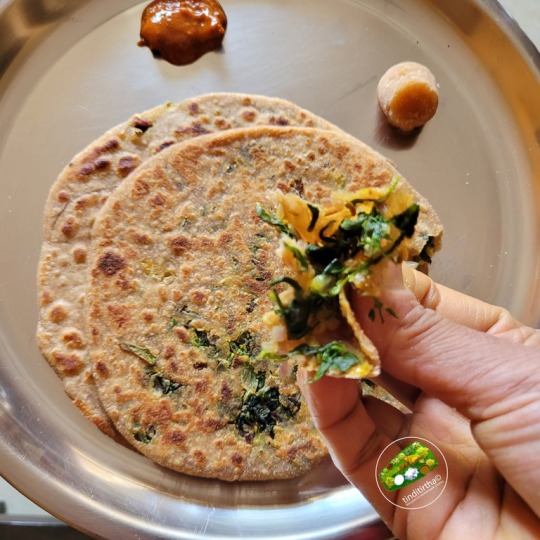
View On WordPress
#BREAKFAST#diabetic friendly#fenugreek leaves paratha#healthy#home made#nutritious#Paratha recipe#yummy and healthy
0 notes
Text
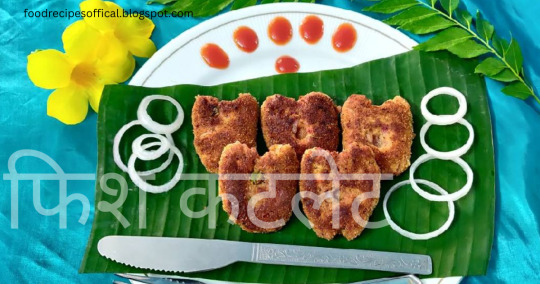
In Food Recipes we teach you how to make fish cutlets. Cutlets are a typical starter in French cuisine. In Indian cuisine, a cutlet is typically a mixture of mashed vegetables (potatoes, carrots, beans) or cooked meat (mutton). , refers to a stuffing of chicken or fish) that is fried with a batter/covering. The meat is cooked with spices – onions, cardamom, cloves, cinnamon, coriander (cilantro), green chillies, lemon and salt. It is then dipped in egg mixture or corn starch and then in bread crumbs (see also breaded cutlet), and fried in ghee or vegetable oil. Mostly chicken and mutton cutlets are very popular snacks in eastern part of India especially in Kolkata. If you are a fish lover then this recipe is for you. Many of you must have tried fish pakora, have you ever eaten fish cutlet. It is very easy to make them. These are crispy fish prepared in potatoes and spices and deep fried. It will prove to be a great snack during the party. Mixing with spices, coating with egg, coating with bread crumbs and corn flour and deep frying. Read more
#Garlic Spinach#Veggie Puffs#Mix Veg#Roasted Potato#Malai Pyaaz#Tawa Pulao#Paneer Tikka#Cheese stick snacks#Bharwan Tamatar#Poha#Paneer butter masala#Thandai Phirni#Fenugreek Muthia#Chilli paneer#https://foodrecipesoffical.blogspot.com/2023/02/food-recipes-samosa.html#Food Recipes समोसा#Samosa#lunch
0 notes
Text
Winter Special Methi Ka Paratha (15 min) - BEST version EVER @mommyskitchenstory.com

Full video - Methi Ka Paratha
#methi paratha#methi ka Paratha#winter Special#winter recipes#foodblogger#mommyskitchenstory#food photography#easytocook#recipes#homemade#yummy#vegrecipe#fenugreek paratha#breakfast recipes#winter foods#comfort food#youtube#recipe video
1 note
·
View note
Text
Methi Thepla Recipe | How to make Methi Thepla
Methi Thepla
Methi thepla is a popular Gujarati flatbread prepared using fenugreek leaves (methi), whole wheat flour, and various spices. It’s a nutritious and tasty dish that can be enjoyed for breakfast, lunch, dinner or while travelling. Here’s a basic recipe to make methi thepla.
Every household has its recipe for making thepla. Some are prepared with a mixture of flour. Like whole wheat…

View On WordPress
#bitter#BREAKFAST#chutney#complex carbohydrates#coriander#cumin#easy breakfast recipe#easy paratha recipe#fenugreek leaves#fiber#GLUTEN-FREE#gram flour#grated coconut#grated vegetables#griddle#Gujarati thepla recipe#healthy paratha for breakfast#healthy paratha recipe#healthy recipes#how to make thepla#Indian flatbread#jowar flour#methi#methi ka paratha#methi paratha recipe#methi recipe#methi thepla by Swati#Methi thepla recipe#minerals#oil
2 notes
·
View notes
Text

Masala Dosa
#food#recipe#breakfast#dosa#curry#potatoes#lentils#rice#onions#fenugreek#peppers#ginger#cilantro#turmeric#indian
64 notes
·
View notes
Text
youtube
0 notes
Text
खाते-खाते कम करनी है पेट की चर्बी, तो मेथी के लड्डू हैं परफेक्ट रेसिपी, जरूर करें ट्राई
खाते-खाते कम करनी है पेट की चर्बी, तो मेथी के लड्डू हैं परफेक्ट रेसिपी, जरूर करें ट्राई
आजकल बढ़ता व��न एक गंभीर समस्या बनता जा रहा है। वजन बढ़ने की समस्या कई अन्य स्वास्थ्य जोखिमों का कारण हो सकती हैं। इसलिए समय रहते अपनी फिटनेस पर ध्यान देना बहुत जरूरी है। हालांकि, बढ़ते वजन से परेशान होकर लोग कई तरह की गतिविधियों में भाग लेते हैं, इसके साथ ही भूखे रहना और डाइटिंग जैसे नुस्खे आजमाते हैं। पर तब आपको कैसा लगेगा, अगर हम कहें कि आप खाते-खाते भी अपना वजन कम कर सकती हैं? जी हां, हमारे…
View On WordPress
#Fenugreek Benefits#fenugreek for weight loss#fenugreek laddu benefits#Hindi News#Hindustan#Methi ke ladoo recipe#methi ladoo benefits#methi ladoo for weight loss#methi ladoo ingredients#methi ladoo recipe in hindi#methi ladoo with jaggery benefits#methi ladoo with jaggery recipe#News in Hindi#मेथी के फायदे#मेथी के लड्डू के फायदे#मेथी के लड्डू खाने के फायदे#मेथी के लड्डू बनाने का तरीका#मेथी के लड्डू बनाने की विधि#मेथी खाने का फायदा#मेथी से वजन कम करना#हिन्दुस्तान
0 notes
Text
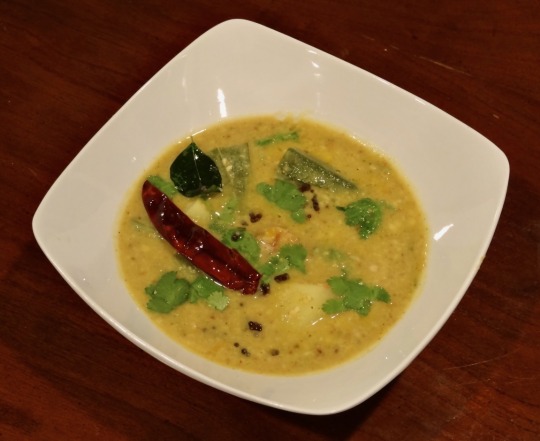
[ID: A bowl of a bright yellow stew topped with cilantro, mustard seed, chili, and curry leaf. End ID]
ಉಡುಪಿ ಸಾಂಬಾರ್ / Udupi sambar
A sambar is a lentil-and-vegetable stew distinguished by the use of a particular spice blend (Hindi: सांबर मसाला "sāmbār masālā," "sambar spice"; Kannada: ಸಾಂಬಾರ್ ಪುಡಿ "sāmbār puḍi," "sambar powder"). Sambars are a staple of South Indian and Sri Lankan cooking, sometimes made in households for multiple meals a week. The word "sambar" can be traced back to the Sanskrit सम्भार "sambhārá," "collection of things required for a particular purpose”; “spices."
The lentil used in sambar dishes is usually tur dal (split pigeon peas), though arhar dal, tuvur dal, or even blends containing masur or mung dal may be used, depending on the cook or the region. Vegetables also vary between combinations of okra, potato, ash gourd (petha), bottle gourd (doodhi / lauki), drumstick (saijan ki phalli), beetroot, tomato, carrot, pumpkin, brinjal, and pearl onions, among others. The sambar masala fries chilis, curry leaves, dal, and various spices including cumin, coriander, and fenugreek, then grinds them into a spicy, earthy, fragrant blend.
This recipe makes a sambar in the style of ಉಡುಪಿ (Udupi) cuisine—a subdivision of the cuisine of the ತುಳುವ (Tuluva) people localised in the Udupi District of Karnataka, a southeastern coastal state of India. (Tuluva cuisine is also commonly found in Dakshina Kannada, Karnataka, and Kasaragod, Kerala). In the Udupi region, sambar may be known as "ಕೊಡೆಲ್" "kodhel"; perhaps related to "ಕಡಲೆ" "kadhale" "Bengal gram"; or "ಹುಲಿ" "huḷi"; "tartness." Udupi huli has coconut oil and jaggery as its primary distinguishing features: the jaggery's deep sweetness and the earthy pungency of unrefined coconut oil combine with the spice of the chilis and the sour fruitiness of the tamarind to create a complex, flavorful, well-balanced dish.
Udupi huli may be further divided into a few major types. ಮಸಾಲೆ ಹುಳಿ ("masāla huḷi") contains shredded coconut and vegetables; ಬೋಳು ಹುಳಿ ("bolu huḷi") contains vegetables, but omits the coconut.
Hotel-style masala huli recipes typically add a lot of jaggery to produce a distinct sweetness; cut back on the amount of coconut included; and contain onion and garlic. The other main type of masala huli—“temple style”—is sattvic (from Sanskrit "सत्त्व" "sattva": "goodness," "essence," "existence"), which in this context means that onions and garlic are excluded.
A sattvic diet in Hinduism centres around the concept of maintaining sattva by eating only pure and mild (sattvic) foods, and omitting tamasic (“dark,” "inert," "destructive"; from Sanskrit तमस् "tamas") and rajasic ("exciting," "passionate," from Sanskrit रजस् "rajas") ones. The concepts of sattva, tamas, and rajas (the गुण "guṇa" system) are central to the construction of caste: the degree to which each person innately inherits each quality supposedly determines their possession of characteristics including honesty, intelligence, and goodness (sattva), stupidity and lack of creativity (tamas), and passion and pridefulness (rajas); the possession of these characteristics in turn determines their rightful place in a professional and social hierarchy. The association of certain foods with certain qualities thus links diet to caste: a distinction in diet is one of the methods by which those belonging to upper castes maintain and police caste boundaries.
This recipe makes enough pudi for one pot of sambar. Traditionally, sambar pudi is created fresh each time the dish is made, but many households make large batches and store them. In this case, omit the coconut; or, use dried coconut and store the masala in the refrigerator.
Recipe under the cut!
Patreon | Paypal | Venmo
Ingredients:
Serves 4-6.
For the sambar:
2 cups chopped vegetables
1 red onion, sliced*
1 cup (200g) yellow split pigeon peas / tur dal / ತೂರ್ ದಾಲ್ (ಹಳದಿ ಸ್ಪ್ಲಿಟ್ ಪಾರಿವಾಳದ ಬಟಾಣಿ)
4 cups (1 litre) water, or as needed
1/4 tsp ground turmeric / haldi / ಅರಿಶಿನ
2 tsp table salt
2 tsp jaggery / gur / ಬೆಲ್ಲ*
1/4 cup (60mL) tamarind pulp (from 1 Tbsp dried tamarind / imlie / ಹುಣಸೆಹಣ್ಣು)
2 tsp unrefined coconut oil / nariyal ka tel / ತೆಂಗಿನ ಎಣ್ಣೆ
Ingredient list format is English / Hindi (Latin transcription) / Kannada. The Hindi is provided for convenience while shopping.
Udupi sambar usually uses any of: gourd, brinjal (Indian eggplant), pumpkin, dumstick (saijan ki phalli), and okra. Pearl onion is not usually used in this region, but you can add whatever you want, according to taste.
*For a hotel-style sambar, include the onion; increase the jaggery to 2 Tbsp.
For the spice paste / sambar masala / ಸಾಂಬಾರ್ ಪುಡಿ ("sambar pudi"):
1/2 Tbsp split Bengal gram / chana dal / ಹಳದಿ ಸ್ಪ್ಲಿಟ್ ಗ್ರಾಂ
2 tsp split black gram / urad dal chilka / ಸ್ಪ್ಲಿಟ್ ಬ್ಲ್ಯಾಕ್ ಗ್ರಾಂ
2 tsp coriander seeds / dhaniya / ಕೊತ್ತಂಬರಿ ಬೀಜದ
1/2 tsp fenugreek seeds / methi / ಮೆಂತ್ಯ
1 tsp cumin seeds / jeera / ಜೀರಿಗೆ
1 tsp ground turmeric
5-6 curry leaves / kari pati / ಕರಿಬೇವು
3-4 Byadagi or other dried red chilis / byadagi mirch / ಬ್ಯಾಡಗಿ ಮೆಣಸಿನಕಾಯಿ
4 cloves garlic, skins on*
Large pinch asafoetida / hing / ಇಂಗು
1 cup (100g) fresh coconut (about one coconut)*
1/2 cup (120mL) water
While the ratio of ingredients in Udupi sambar pudi vary slightly, the ingredients themselves are almost always consistent.
*For a hotel-style sambar, include the garlic, and decrease the coconut in the sambar masala to 1/4 or 1/2 cup (25-50g).
The grams and pulses in this pudi have many different names. You can find them in a halal or South Asian grocery store; look on the bag for the Hindi names (since they have been transcribed into Latin, the spelling may vary from what you see here).
The urad dal you find may be husked, and thus yellow instead of black; these will work just as well.
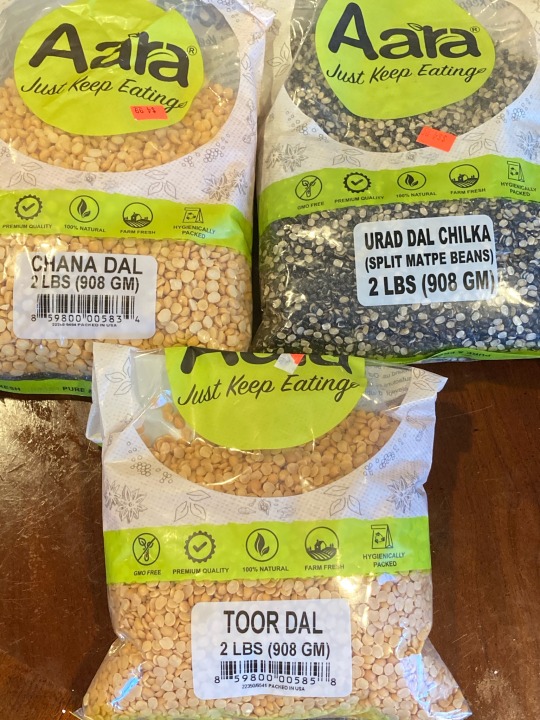
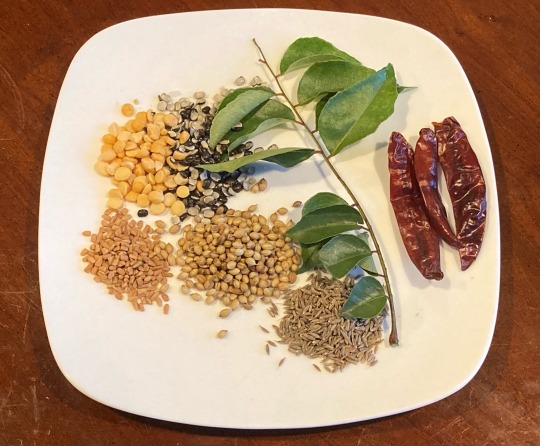
For the tempering / tadka / ಹದಗೊಳಿಸುವ:
2 Tbsp unrefined coconut oil
2 red chilis
8 curry leaves
1 tsp brown mustard seeds / rai / ಸಾಸಿವೆ ಬೀಜಗಳು
Recipes from north Karnataka may add cumin and whole, unpeeled garlic cloves to the tempering.
Instructions:
For the sambar pudi:
1. Break open the coconut and remove and shread its flesh.
If using a whole dried coconut, break into the shell with the wrong side of a hammer and pry open. Break into a few smaller pieces and peel with a vegetable peeler until the skin is removed from the white flesh, wearing something to protect your hand. Soak in warm water for several minutes to soften, and then grate or food process.

2. Heat 2 Tbsp of coconut oil in a skillet on medium-low. Add asafoetida and fry for 30 seconds, until no longer raw-smelling. Add dal and fry, stirring often, for 30 seconds until golden brown; add coriander, mustard, fenugreek, and cumin seeds and fry until fragrant.
3. Add curry leaves and fry until wilted, then add garlic and dried chilis and fry another 30 seconds to a minute, until fragrant.
4. Add coconut and fry, stirring often, for another few minutes until a shade darker. Add turmeric and stir.
5. Grind all ingredients into a paste in a mortar and pestle, then mix in about 1/2 cup water to loosen (if using dried coconut, you may need more water).
Or, put all ingredients along with 1/2 cup water into a blender or food processor and process until a relatively smooth paste forms.
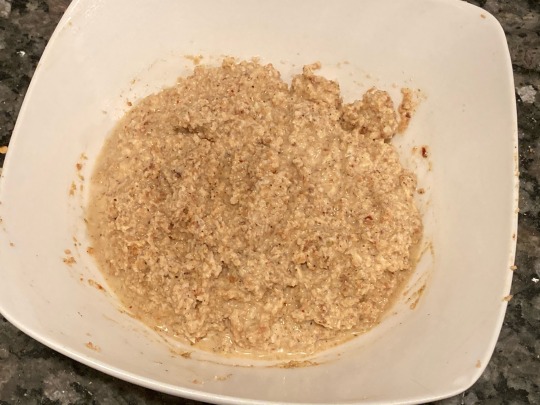
For the sambar:
1. Wash tur dal to remove excess starch. Simmer dal with 2 cups water, 1/4 tsp ground turmeric, and 1 tsp coconut oil for about 30 minutes until very tender. Mash until relatively smooth with a wooden spoon or bean masher, or process briefly with an immersion blender.
You may soak the dal in water after rinsing them to reduce the cooking time, but it is not necessary.
2. Meanwhile, make the tamarind paste. Soak 1 Tbsp tamarind dried pulp in 1/4 cup hot water for 20-30 minutes. Squeeze the tamarind into the water to extract the pulp. Discard the tamarind seeds and husk. Optionally, depending on your preferred texture, push the mixture through a metal sieve.
3. Prepare vegetables. Slice the onion; remove ends of okra and drumsticks and cut into 2-inch pieces; quarter tomatoes; quarter brinjal; peel pumpkin and cut into cubes; peel and cube potatoes.
4. If using onion, add a teaspoon of coconut oil to a large pot and fry until translucent.
5. In the same pot, boil vegetables in just enough water to cover, along with a pinch of salt, until they are beginning to soften.
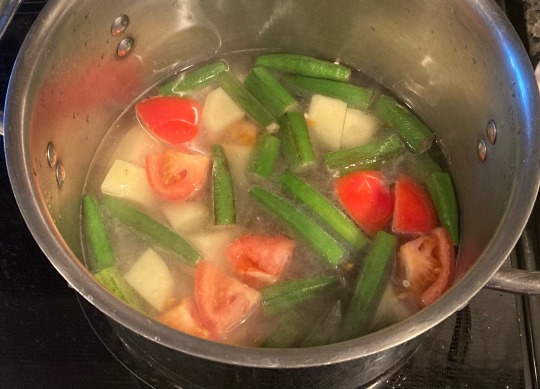
Some recipes call for the vegetables to be boiled, and others call for them to be steamed. I prefer boiling, since it produces a nice savory broth.
6. Mix vegetables, dal, tamarind, jaggery, sambar pudi, and salt to taste and simmer 5-10 minutes to allow flavors to combine and vegetables to cook under tender. Add water as needed. Remove from heat and stir in cilantro. Taste and adjust salt.
The final sambar should be pourable, like a thick soup—Karnataka sambar is typically thinner in consistency than Tamil Nadu versions.
For the tadka:
1. Heat coconut oil in a small skillet on medium heat. Add tempering ingredients and fry, stirring often, until chilis and curry leaves are a couple shades darker and the mixture is fragrant.
2. Pour the oil and tempering ingredients into the sambar and stir in. If you like, retain some of the tadka as a garnish to serve.
3. Serve warm, in individual bowls, alongside long-grain white rice. To eat drumsticks, scoop the center out and eat it; the tough outer rind is left.
If you intend to save some sambar, it's a good idea to make just enough tadka for what you plan to eat that day, and then make fresh tadka to pour over the reheated leftovers.
106 notes
·
View notes
Text
Recipe #5 - Qwarkhey/Lal Lobia
Ingredients:
2 cans kidney beans
1/2 of a large onion, chopped
3/4th teaspoon coriander powder
1 teaspoon garam masala
1 1/2 teaspoon red chili powder
1 1/2 tsp cumin seeds
1 tsp lemon juice
3 tsp oil or ghee
Pinch of salt
A pinch of various other seasonings can be added to taste (I use 1tsp of a mixture of fenugreek, cinnamon, cumin, coriander, garlic powder, black pepper, ginger, turmeric)
Recipe:
Place the oil in a pot along with 1/2 tsp of cumin.
Leave them until they release a scent, but not for longer than 30 seconds to a minute.
Add the onions and saute until golden brown
Add the beans, the rest of the spices, and the lemon juice
Add boiling water, the amount depends on how "soupy" you want it to be. Not more than 1 cup.
Cook for 16 minutes.
Can be cooked longer to be less soupy, can add more boiling water for more soupy. It's more flavorful if you let it boil down a little bit, but soupy is good if you want to have more of it
Serve flatbread (roti, naan, or pita are my suggestions) or rice

Submitted by @mothfishing
33 notes
·
View notes